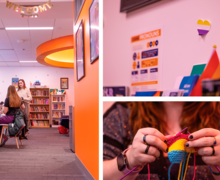Actress Gina Belafonte discusses experiences, perception of race in media
Gina Belafonte, daughter of Caribbean music pioneer Harry Belafonte, spoke at the S.I. Newhouse School of Public Communications on Wednesday about her father’s life and race in the media.
A day after screening her documentary, “Sing Your Song,” the actress and producer spoke in the JoyceHergenhan Auditorium, telling the story of her father’s legendary career as a musician and social activist, and discussing her journey as a biracial actress in Hollywood.
Richard Dubin, a television, radio and film professor, hosted the discussion, which was the 12th annual “Conversation on Race and Entertainment Media.” During the talk, Belafonte touched on hardships she experienced as a half-white, half-black woman in show business, and her dilemma with public identity.
“When someone first found out that my last name was Belafonte, they’d ask me if I were Italian,” she said. “But then when they found out that Harry Belafonte was my father, you know, a black man, I’d watch this whole shift in energy from them, almost as if they were confused. It’s unfortunate, that we have to figure out what race we are. We’re human.”
Belafonte talked about her father, who is recognized as the “King of Calypso” and best known for his popular “Banana Boat” song. But he also served as a connection between the civil rights movement and the politics of the 1960s. This unsung story of connecting civil rights with entertainment was told in Belafonte’s documentary, which prominently featured the untold story of her father’s role in the civil rights movement.
“I think the documentary was really significant. It told a deep story between the political movement and how the media industry played a big role in it,” said Claire Pedulla, a junior sculpture major.
The conversation continued to talk about how the representation of blacks in the media has changed dramatically from when she started acting, and how the issue of race in the media has moved from a cultural gap to a socioeconomic gap.
Belafonte gave examples from her career as an actress, referencing a time when she was the only black character as a guest on the sitcom “Friends.”
“It’s fascinating, how a show was set in the heart of New York City, and there wasn’t a single black character,” Belafonte said.
She admitted blacks now have a stronger presence in entertainment, but still fail to address many real-life issues.
“For me, it’s not a black or white issue about representation in the media anymore,” she said. “It’s become so homogenized that race issues don’t really matter. What’s not being shown, and needs to be, are the socioeconomic issues that are going on.”
Losa Amara Meru, a freshman television, radio and film major, said Belafonte’s discussion showed an interesting point of view regarding race in entertainment media and a great in-depth perspective.
“I’m mixed race myself, so I wanted to see what a person like me had to do to be successful,” she said. “She gave us advice to create our own content and set our own path as a multi-ethnic group, and I just thought it was great.”
Belafonte’s discussion on race in the media drew diverse students to the lecture, eager to hear her opinion on the topic.
JoAnn Yao, a television, radio and film graduate student, said she personally connected with the discussion.
Said Yao: “Race has played such a huge role in my life. I always try to engage in conversations like these because it’s easy for everyone else to ignore it because it’s not an issue for them. It’s usually forgotten.”
Published on February 14, 2013 at 12:09 am
Contact Alfred: alng@syr.edu
@alfredwkng





